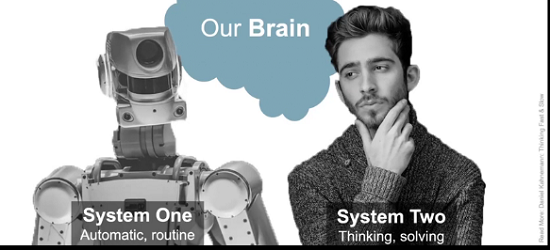(Behavioural Economics cont. 2)
Fast and Slow Thinking as Part of Behavioural Economics
Introduction
This involves understanding 'fast' (system 1) and 'slow' thinking (system 2) (for more details, see elsewhere in the Knowledge Base).
Fast thinking

It is
- fast
- unconscious
- uncontrolled
- automatic
- reactive
- routine
- predictable
- intuitive
- requires minimal effort, ie effortless
- based on heuristics (ie models for framing thoughts, etc)
- associative
- very error prone
- your instinct or gut response based on 'tacit advanced pattern recognition' eg what a subject matter expert knows
- skilled, ie once you have learnt how to do something, you can perform complicated tasks like bike riding, car driving, etc without conscious thought.
This is linked with expertise, ie if you have expertise in a specific area, you will develop 'tactic pattern recognition' in that area which is sometimes called 'gut instinct'. An example is when an art expert, at first sight, recognised the below sculpture as a fake, despite scientific tests initially stating otherwise. The expert was unable to explain how he came to the decision but he was right!!

(source: Arun Pradhan, 2019)
An example of fasting thinking is
"... if you have ever left the house wondering if you locked the door or arrived at your destination and can't remember the journey..."
Edwina Pike, 2022
Another example is using checklists, ie don't have to think about what needs to be checked as it is listed for you
Slow thinking is

- slow
- conscious
- self-aware
- reliable
- reflective
- rational
- deliberate
- controlled
- effortful
- deductive
- uses rules, regulations, criteria and frameworks, etc
- uses the thinking and problem-solving part of the brain that requires considerably more effort and energy
- where insights are developedy
- handles uncertainty, etc.

(source: Edwina Pike, 2022)
Slow thinking assumes people
- pay attention
- remember
- understand the importance of change
- consciously alter their behaviour when presented with something rational
- apply their learnings
- act in their best interests
- collaborate
- respond to incentives and KPIs
- work rationally and thoughtfully
(source: Arun Pradhan, 2019)
Based on the above elements, you tend to design projects on slow thinking, because with fast thinking as you are liable to make too many mistakes.
However, using your slow thinking brain can be exhausting (mentally, physically and emotionally). Slow thinking
"...is really smart but requires high maintenance..."
Edwina Pike, 2022
By repetition, ie countless hours of practice of an activity you can move a task from slow thinking to fast thinking.
Comments on fast and slow thinking
Fast thinking is your gut reaction, while slow thinking is your conscious will.
Fast thinking is based on 'no surprises', ie nothing stands out as unusual or different in your routine. However, if there are surprises, or changes in your routine, then slow thinking kicks in.
However, using your slow thinking brain can be exhausting (mentally, physically and emotionally). Slow thinking
"...is really smart but requires high maintenance..."
Edwina Pike, 2022
Traditionally, economics has been based on slow thinking; it has revolved around assumption that people are rational and unbiased in their analysis and decision-making, ie act in their own self-interest; make considered decisions; act like robots; the more options to choose from the better, ie
"...the more choice you have, the more likely it is you'll be able to find the program that suits your specific needs..."
Richard Thaler et al, 2021
This is claimed to give you freedom of choice and that one-size does not fit all, ie each individual's needs are unique!!!
However, in reality it is very different, ie the more complicated and/or the more options people have, the more they can become overwhelmed. Consequently, they need more help with their decision-making; people are not rational in their decision-making, etc.
There is evidence that voters tend to favour a fast thinking system, ie
"...a candidate who makes a bad first impression, or tries to win voters by complex arguments statistical demonstration may well run into trouble..."
Richard Thaler et al, 2021
As most people speak their native languages using fast thinking and then try to speak an additional language using slow thinking; however, being truly bilingual means that you speak 2 languages using the fast thinking mode.
